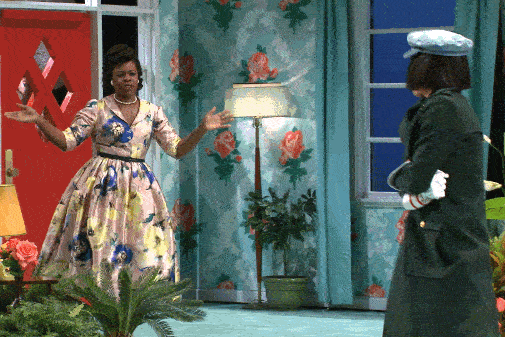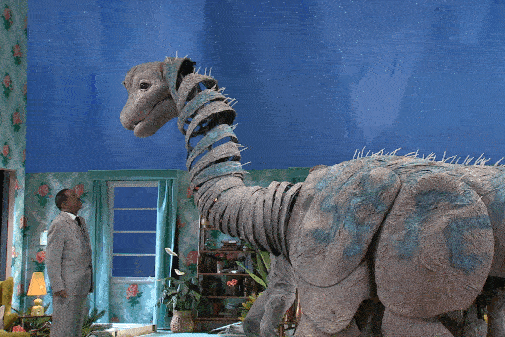A lot of weird things happen over the course of the three hours of The Skin of Our Teeth: an Ice Age, a flood, a war, several radio announcements and dance breaks, fourth-wall-breaking asides to the audience, even a bit of onstage vaping. But the breakout stars of the show (alongside Gabby Beans’s Eartha Kitt–doing–Yzma–level voice work) are the creatures who have been dead for eons. In Act One, we meet the Antrobus family in Excelsior, New Jersey, in the midst of an Ice Age, and they happen to live alongside a gigantic brontosaurus and a mammoth, both of which they treat like ordinary house pets.
The puppets, it turns out, were designed and built by James Ortiz, whose large-scale work has previously appeared, among other places, in the Public’s Public Works version of Hercules. He’d worked on a production of The Skin of Our Teeth in Baltimore, and he says that when he heard LCT was doing its own, he “put out feelers” to see if they would use puppets too. (Often they’re just played by actors in mascot-style suits.) Then he heard from director Lileana Blain-Cruz, who told him she did indeed want puppets, and she wanted to go big. “Her approach was, Let’s not stylize them too much. Let’s not make them a broom and an eyeball. Let’s mean it,” Ortiz said. “There’s a scale of this theater where you just go, We’re not going to kid our way into doing this.”
Thornton Wilder doesn’t specify a species of dinosaur in his script, but Blain-Cruz decided she wanted a brontosaurus to get the “Jurassic Park moment” of seeing such a large creature enter the doorway of the Antrobuses’ home and fill up the Vivian Beaumont’s stage. Both puppets are made of “a type of foam that’s somewhere in between a mouse pad and craft foam from Michael’s,” according to Ortiz, which is to say that it’s light but stiff enough to build a large shape. The dinosaur’s skin is composed of a synthetic fabric that has been heated and puckered to resemble scales, and the mammoth’s fur is torn up pieces of dyed terry cloth “so that it has a delicious bounce and movement to it.”
It takes three people to operate the dinosaur (Jeremy Gallardo, Beau Thom, and Alphonso Walker Jr.), whereas the mammoth is a solo job (done by Sarin Monae West). In the case of the dino, the actors sync their movements by breathing. “An inhale lets everyone know something is going to happen, and the exhale is that action,” Ortiz says. They’re on a live mic, so the audience hears the big creature breathe in and out. “The fact that the puppet is breathing is the first beginning to making it live.”
Ortiz developed the creatures’ movements in rehearsals, giving the puppeteers space to imbue the beings with personality once they figured out the basics of the blocking. They’re cuddly: They vie for the Antrobuses’ attention like dogs looking to be petted and even get into high jinks in the house, trying to steal the hat of a telegraph deliverer (Lindsay Rico) or climbing up on an ottoman. Occasionally, they break sauropod character to talk back to the Antrobuses, acting insulted when referred to as “stupid animals.” “We let those grace notes be grace notes and have the behavior be pets,” Oritz said. “Because that behavior makes them all the more endearing. Our lizard brains in the audience go, ‘That’s my dog!’”





